Dopo la nostra decennale esperienza sulla distribuzione di prodotti per l’energia rinnovabile notiamo ancora che esiste una grande confusione sulla differenza tra la tecnologia MPPT e tecnologia PWM presente su prodotti come Regolatori di Carica o Inverter. Questa confusione è dovuta dalle troppe informazioni molto spesso sono incomplete o del tutto sbagliate presenti sul web, spingendomi a scrivere un breve articolo sul nostro blog in modo da fare chiarezza.
Il regolatore di carica con tecnologia PWM o MPPT sono largamente utilizzati per caricare le proprie batterie prelevando energia da pannelli solari fotovoltaici. Oggigiorno in commercio esistono diversi modelli di diversa marca con diverse caratteristiche tecniche tali da poter scegliere il modello migliore per il proprio sistema.
I regolatori di carica con tecnologia PWM hanno un concetto molto semplice di funzionamento:
la tensione di lavoro in ingresso, proveniente dal pannello solare, deve essere necessariamente simile (non uguale) alla tensione di lavoro delle batterie, differendo solo di qualche decimo di Volt, in modo da determinare la circolazione di corrente dal pannello solare fotovoltaico verso la batteria. Tale funzionamento avviene solo perché il circuito elettronico del regolatore PWM è molto semplice e permette di connettere “direttamente” il pannello fotovoltaico alla batteria ,naturalmente il regolatore è dotato di un algoritmo che gestisce la carica della batteria proteggendola. Grazie alla semplicità del circuito elettronico, il Regolatore PWM ha un prezzo più conveniente rispetto ad un Regolatore MPPT.
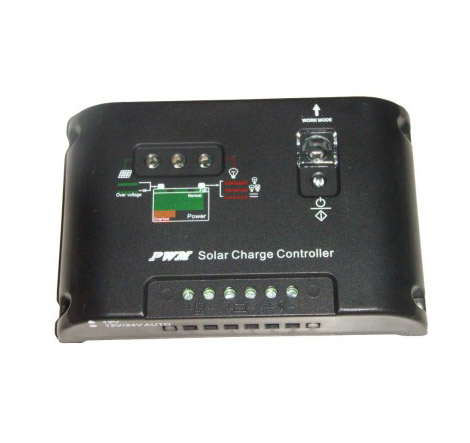
Regolatore di carica
I
regolatori di carica con tecnologia MPPT (Maximum Power Point Tracker) hanno un concetto di funzionamento differente dal PWM:
la potenza di ingresso prodotta dal pannello solare deve essere simile alla potenza di carica delle batterie. Per gestire la potenza
, i regolatori MPPT hanno un circuito elettronico più complesso, con un numero maggiore di componenti elettronici di grossa taglia ( Condensatori, Bobine, ecc) che ne aumentano le dimensioni fisiche rispetto ad un normale regolatore PWM ed è più costoso.
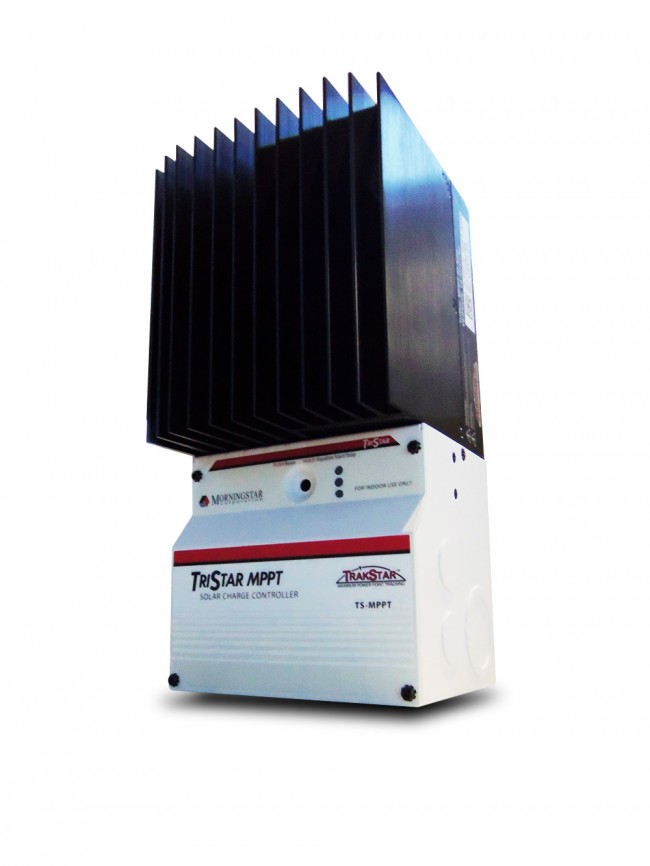
regolatore MPPT
Quindi:
DIFFIDATE DA COLORO CHE VENDONO REGOLATORI DI CARICA CON DIMENSIONI DI UN SEMPLICE PWM E LO DICHIARANO MPPT!!!!
In commercio esistono pannelli solari fotovoltaici di diversa tecnologia (policristallino, monocristallino, armofo) che generano una tensione massima di lavoro (Vmp) a 17-18V , comunemente chiamati a 12V, ed altri ancora che generano una tensione massima di lavoro intorno ai 30-32V chiamati comunemente a 24V.
Se prendiamo in considerazione un nostro prodotto NX100P (
link del prodotto) con le seguenti caratteristiche tecniche:
SKU NX100P
Cod. EAN 7427509530532
Potenza Nominale (W) 100
Tensione a punto massimo (Vmp) 17.60
Tensione a circuito aperto (Voc) 21.9
Corrente a corto circuito (Isc) 6.14
Corrente a punto massimo (Imp) 5.68
Quindi osservando le caratteristiche tecniche del pannello solare notiamo che la tensione è di 17.60V, quindi utile per lavorare in un sistema a 12V (con un'unica batteria), e la corrente è di 5.68A e quindi può lavorare con un regolatore con una corrente massima di 10A. In questo caso si può utilizzare sia la tecnologia MPPT che la tecnologia PWM.
Cosa succede se utilizzassimo un Regolatore PWM piuttosto che un Regolatore MPPT?
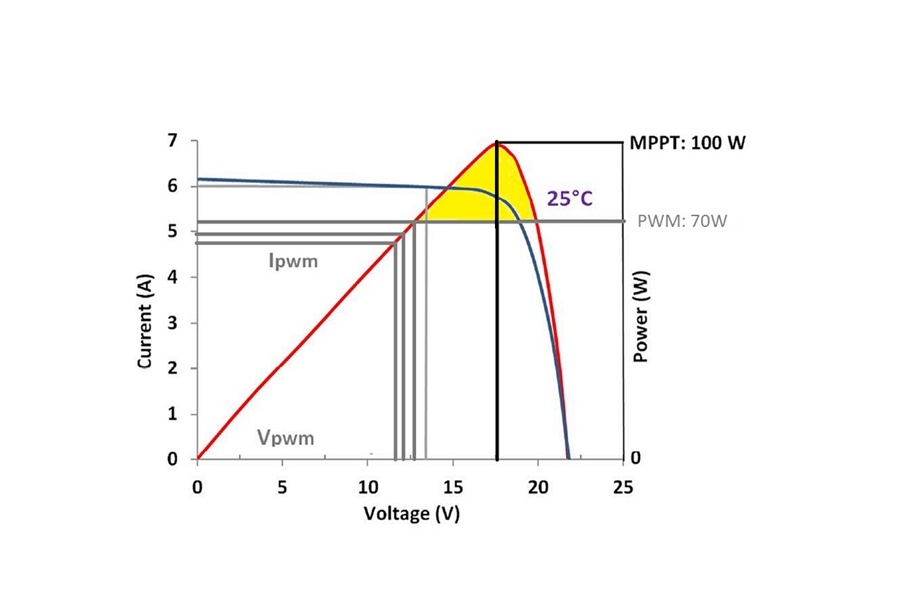
grafico regolatore PWM e MPPT
Se si usa un
Regolatore PWM (guardare le linee grigie), e considerando una condizione ideale di produzione del pannello fotovoltaico, notiamo che la tensione Vpwm (tensione batteria) è intorno a 12-13V quindi il pannello non lavora più alla sua tensione nominale (17.60V) ma a tensione batteria riducendo la produzione del pannello solare fino a 70W anche se la corrente che entra nel regolatore PWM e quella che esce sono intorno a 5A. Se varia la tensione batteria si noterà che varierà la posizione delle linee grigie lungo lungo la linea rossa che indentifica la curva di produzione del pannello solare. Invece, utilizzando un
Regolatore MPPT, si nota che il pannello solare, pur lavorando alla tensione e corrente nominale, riesce a produrre 100W anche se le batterie sono intorno a 12-13V ottenendo un miglioramento sulla produzione intorno 20-30% (
zona gialla) rispetto all’utilizzo di regolatore PWM.
La ragione per cui il
regolatore MPPT permette un aumento di produzione è dovuto proprio dalla sua logica di funzionamento ( la potenza in ingresso è uguale alla potenza di uscita) e suddivide in modo netto la sezione fotovoltaica e la sezione batteria. Facciamo un esempio con calcoli molto semplici senza entrare nella complessità dei calcoli tecnici:
Pfotovoltaico= Vmp*Imp=17.60V*5.68A=100W
Ibatteria= Pfotovoltaico/Vbatteria=100W/12V= 8.3A
Ciò significa che all’uscita del regolatore non avremo 5.68A ma 8.3A.
In Conclusione il regolatore MPPT è in grado di convertire i parametri elettrici come tensione e corrente e ciò significa che:
SE SI HA UN PANNELLO A 24V E SI VUOLE CONNETTERE AD UNA SOLA BATTERIA, QUINDI LAVORARE A 12V, E’ STRETTAMENTE NECESSARIO UTILIZZARE UN REGOLATORE MPPT.
Autore: Gianbattista Diciolla
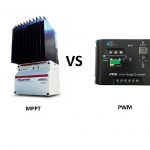
 Regolatore di carica
Regolatore di carica regolatore MPPT
regolatore MPPT grafico regolatore PWM e MPPT
grafico regolatore PWM e MPPT
 Energiasolare100.com
Energiasolare100.com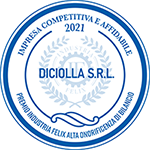

Se si hanno due o tre batterie collegate in parallelo va comunque bene un regolatore MPPT ? Grazie
F. Marnini
Si va bene, ma bisogna vedere prima come sono collegati i pannelli e capire come è strutturato l'impianto. Per informazioni più precise non esiti a contattarci, l'aiuteremo nella giusta scelta.
Ho letto con interesse l' articolo. La situazione mi sembra piuttosto chiara quando ci sono solo pannelli solari ed una sola batteria o un solo gruppo di batterie. Trasmetto qui di seguito una mia mail ad un forum in lingua inglese in cui chiedo aiuto e pongo 5 quesiti. Non ho ancora ricevuto risposta dal forum. Sarei molto contento di poter ricevere la sua opinione/risposta in merito a ciascuno dei miei quesiti. Grazie in anticipo.
Hi,
we read in the literature about the respective merits of PWM and MPPT solar charger devices and the basic principles of good maintenance practices for batteries, and in particular for lead acid batteries in their several variants (flooded, gel, sealed, AGM to mention a few). However it looks like to me that theory is easy to apply only when the system has a single charging source and a single battery (or single battery bank). Even in a simple boat like mine that is not the case.
I have 4 different charging sources: the alternator, a wind generator, 2 solar panels (from the same manufacturer and of equal characteristics connected in parallel) and a 4-stage mains battery charger for shore connection.
The boat has 3 battery banks: a single starting battery for the engine, a single battery for the bowthruster, and 3 equal batteries connected in parallel for everything else (3 x 100 Ah).
The alternator charges all 3 battery banks.
The shore connection charger charges all 3 banks.
The wind generator charges only the 3 x 100 Ah batteries;
The 2 solar panels normally charge only the 3 x 100 Ah batteries but one of them can be switched from the 3 x 100 Ah batteries to charge engine and bowthruster batteries.
The system has worked reasonably well because I never had to hook up to mains in a marina and I have never had to run the engine to charge the batteries (although obviously if I run the engine because I am motoring the alternator charges all three batteries banks through a 3-point battery isolator).
- Here I have my question N. 1:
the alternator has an internal voltage regulator but being old the regulator is not “smart” and therefore an external “smart” regulator could be added to optimize the charge and in theory to prolong battery life as well. However since the optimum charge curve is probably different for each of the 3 battery banks, would the smart regulator be at all useful ?
It goes without saying that the different optimum charge profile of the 3 battery banks is only one of the variables that could interfere with the operation of the smart charger; in fact if the boat was motoring in daylight and on a windy day, the smart charger would have to be smart enough not to be “confused” by the voltages produced by wind generator and solar panels as well.
As I mentioned, the engine start battery and bowthruster battery are charged by the alternator when motoring but when I do not use the boat for months (say in Winter) I can switch one of the two solar panels from the main battery bank and connect it through a dedicated dual battery MPPT charger to the two batteries (engine and bowthruster); it will keep them charged by compensating for the battery self discharge . This has worked very well because when a few days ago I ran a check of each individual battery with a battery tester: the engine and bowthruster batteries were good, the 3 main batteries on the other hand were no longer good. I should add that I renewed all batteries just over 3.5 years ago. I would have expected the 3 x 100 Ah SLB batteries to last longer.
Even though I understand that the 3 main batteries are “cycled” much more than the others, they were never discharged by more than around 30 % according to my battery monitor. I therefore suspect that the combination of alternator charging (when motoring), PWM solar charger and wind generator may have something to do with their short life. In particular the PWM charger would tend to keep the voltage on the batteries at, I believe, around 14.3 V, while the wind generator (Silentwind 400W) has a dedicated voltage regulator with a variable voltage output; it stops the blades from turning and therefore stops the charge when the output voltage reaches 15V. I have noticed that when there is a strongish wind this happens frequently. Voltages close to 15V mean, I believe, overcharging of the batteries.
I have here 4 more questions:
N. 2: Can this combination of steady PWM solar charger voltage and fluctuating overcharge due to the wind generator shorten the life of the batteries in the long run ?
N. 3: Could the PWM charger be damaged by the overvoltage (15V) applied to its output by the wind generator ?
N. 4: Would you confirm that replacing the PWM charger with an MPPT would be pointless due to the presence of the wind generator whose voltage output would “fool” the MPPT as regard to the real state of charge of the batteries ?
N. 5: What can be done to improve my charging system ?
I look forward to your reply with hope. Thank you.
Kind regards,
Alberto Fioretti